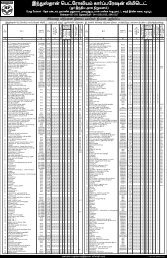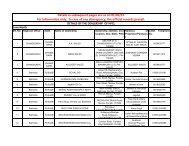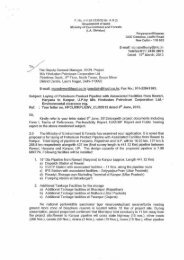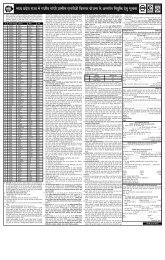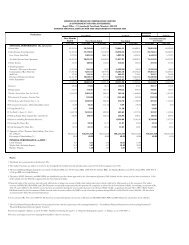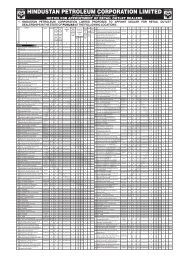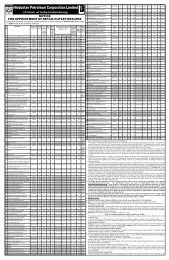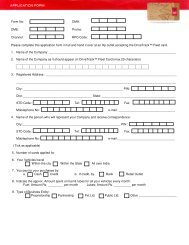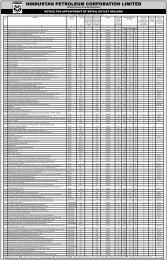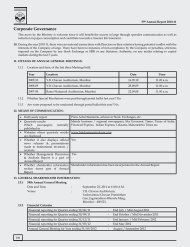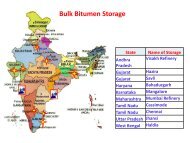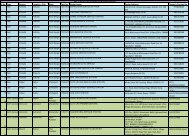HP Bitumen Handbook - Hindustan Petroleum Corporation Limited
HP Bitumen Handbook - Hindustan Petroleum Corporation Limited
HP Bitumen Handbook - Hindustan Petroleum Corporation Limited
You also want an ePaper? Increase the reach of your titles
YUMPU automatically turns print PDFs into web optimized ePapers that Google loves.
<strong>HP</strong> BITUMEN HANDBOOK<br />
“Ourr dutty makes us do tthiings wellll,,<br />
butt yourr belliieff iin <strong>HP</strong> makes us do tthem beauttiiffulllly”
contents<br />
Chapters<br />
1 Introduction 1<br />
Page no.<br />
2 Types of <strong>Bitumen</strong> 2 - 3<br />
3 Introduction to Viscosity Grade 4<br />
4 Properties of <strong>Bitumen</strong> 5 - 6<br />
5 Advantages of Viscosity Grade 7 - 8<br />
6 Tests for VG Grade <strong>Bitumen</strong> 9 - 13<br />
7 Aging of <strong>Bitumen</strong> 14 - 15<br />
8 Field Abnormality 16 - 18<br />
9 Modified <strong>Bitumen</strong> 19 - 20<br />
10 Health, Safety & Environmental Aspects 21<br />
11 <strong>Bitumen</strong> Requirements for Various Types of Road 22 - 23<br />
Applications<br />
12 Recommended Handling Temperatures 24<br />
13 Role of <strong>Hindustan</strong> <strong>Petroleum</strong> in <strong>Bitumen</strong><br />
Marketing<br />
25 - 28<br />
Appendix – I<br />
1 The Fever Chart 29<br />
2 Road Metals and Materials 30 – 39<br />
Appendix – II<br />
1 List of Frequently Used Codes, Specifications & 40 – 41<br />
Standards<br />
2 Commonly used Conversion Factors 42 – 43<br />
3 Customer Sales Offices 44 – 46
1. iNTRODUCTION<br />
<strong>Bitumen</strong><br />
manufactured<br />
is<br />
from<br />
crude oil. <strong>Bitumen</strong> is<br />
obtained as the last<br />
residue in fractional<br />
distillation of crude<br />
petroleum.<br />
Crude<br />
petroleum is a<br />
mixture<br />
hydrocarbons<br />
of<br />
of<br />
FIELD STORAGE<br />
different molecular weights. In the petroleum refineries the individual<br />
components like LPG, naphtha, Kerosene, Diesel etc. are separated<br />
through the process of fractional distillation.<br />
Refinery Operation<br />
PUMPING<br />
STATION<br />
The heaviest material<br />
obtained from the fractional distillation process is further treated and<br />
blended to make different grades of paving grade bitumen.<br />
GAS<br />
STORAGE<br />
PETROLEUM<br />
TOWER<br />
DISTILLATION<br />
REFINERY<br />
SAND AND WATER<br />
TUBE<br />
HEATER<br />
CONDENSERS<br />
AND<br />
AIR<br />
COOLERS<br />
STILL<br />
RESIDUUM<br />
OR<br />
AIR<br />
BLOWN<br />
ASPHALT<br />
LIGHT DISTILLATE<br />
MEDIUM DISTILLATE<br />
HEAVY DISTILLATE<br />
PROCESS<br />
UNIT<br />
ASPHALT<br />
CEMENTS<br />
FOR PROCESSING INTO<br />
EMULSIFIED AND<br />
CUTBACK ASPHALTS<br />
The actual bitumen output can be controlled not only by selecting the<br />
appropriate crude but also by adopting varying processes in the refinery.<br />
The choice of process would depend on the availability of suitable crude,<br />
demand of the end products and total commercial viability of the<br />
complete refining process.<br />
Definition: <strong>Bitumen</strong> is defined as “A viscous liquid, or a solid, consisting<br />
essentially of hydrocarbons and their derivatives, which is soluble in trichloro-ethyelene<br />
and is substantially nonvolatile and softens gradually<br />
when heated. It is black or brown in colour & posseses waterproofing<br />
and adhesive properties. It is obtained by refinery processes from<br />
petroleum, and is also found as a natural deposit or as a component of<br />
naturally occurring asphalt, in which it is associated with mineral matte.<br />
1
2. TYPES OF BUTUMEN<br />
<strong>Bitumen</strong> or bituminous binder available in India is mainly of the following types:<br />
2.1 Penetration Grade<br />
2.1.1<strong>Bitumen</strong> 80/100: The characteristics of this grade confirm to that of S 90<br />
grade of IS-73-1992. This is the softest of all grades available in India. This is<br />
suitable for low volume roads and is still widely used in the country.<br />
2.1.2 <strong>Bitumen</strong> 60/70: This grade is harder than 80/100 and can withstand higher<br />
traffic loads. The characteristics of this grade confirm to that of S 65 grade of IS-<br />
73-1992. It is presently used mainly in construction of National Highways & State<br />
Highways.<br />
2.1.3 <strong>Bitumen</strong> 30/40: This is the hardest of all the grades and can withstand<br />
very heavy traffic loads. The characteristics of this grade confirm to that of S 35<br />
grade of IS-73-1992. <strong>Bitumen</strong> 30/40 is used in specialized applications like<br />
airport runways and also in very heavy traffic volume roads in coastal cities in the<br />
country.<br />
2.2 Industrial grade bitumen.<br />
Industrial grade bitumen is also known as blown bitumen. This is obtained by<br />
blowing air into hot bitumen at high temperatures (normally beyond 180 0 C).<br />
Blowing hot air into bitumen at high temperatures results in structural changes in<br />
bitumen. Esters are formed in this process and these esters link up two different<br />
molecules and higher molecular weight material increases drastically. In the<br />
process the asphaltene content is increased which in turn results in higher<br />
softening points and very low penetration number. Industrial grade bitumen<br />
is used in industrial applications and in water proofing, tarfelting etc.<br />
2.3 Cutback<br />
Cutback is a free flowing liquid at normal temperatures and is obtained by<br />
fluxing bitumen with suitable solvents. The viscosity of bitumen is reduced<br />
substantially by adding kerosene or any other solvent. Cutback has been used<br />
in tack coat applications.<br />
2
2. TYPES OF BUTUMEN<br />
2.4 <strong>Bitumen</strong> Emulsion<br />
<strong>Bitumen</strong> emulsion is a free flowing liquid at ambient temperatures. <strong>Bitumen</strong><br />
emulsion is a stable dispersion of fine globules of bitumen in continuous water<br />
phase. Dispersion is obtained by processing bitumen and water under controlled<br />
conditions through a colloidal mill together with selected additives. The use of<br />
proper quality emulsifiers is essential to ensure that the emulsion has stability<br />
over time and also that it breaks and sets when applied on aggregates/road<br />
surface. It is chocolate brown free flowing liquid at room temperature. <strong>Bitumen</strong><br />
Emulsions can be of two types cationic & anionic. Anionic bitumen emulsions<br />
are generally not used in road construction as generally siliceous aggregate is<br />
used in road construction. Anionic bitumen emulsions do not give good<br />
performance with siliceous whereas cationic bitumen emulsions give good<br />
performance with these aggregates. Therefore, cationic bitumen emulsions<br />
are far more popular than anionic bitumen emulsions.<br />
2.5 Modified <strong>Bitumen</strong><br />
Modified <strong>Bitumen</strong> are bitumen with additives. These additives help in further<br />
enhancing the properties of bituminous pavements. Pavements constructed with<br />
Modified <strong>Bitumen</strong> last longer which automatically translates into reduced<br />
overlays. Pavements constructed with Modified <strong>Bitumen</strong>s can be economical if<br />
the overall lifecycle cost of the pavement is taken into consideration.<br />
2.6. Viscosity grade <strong>Bitumen</strong>:<br />
The new method of grading the product has now rested on the viscosity of the<br />
<strong>Bitumen</strong> (at 60 0 C and 135 0 C). The new grades have thus evolved with<br />
nomenclature:<br />
Grades<br />
Minimum of Absolute<br />
viscosity, Poise@ 60 0 C<br />
Approximate<br />
penetration grade<br />
VG 10 800 80-100<br />
VG 20 1600 ------<br />
VG 30 2400 60-70<br />
VG 40 3200 30-40/40-50<br />
3
3. INTRODUCTION to viscosity grade<br />
Paving grade bitumen is the bitumen obtained from refineries and conforms to IS<br />
73. Recently, the third revision of Indian Standards for Paving <strong>Bitumen</strong><br />
Specifications<br />
IS 73:2006 has been released by Bureau of Indian Standards. Three grades of<br />
<strong>Bitumen</strong> confirming to IS 73: 1992 are manufactured in India. In this third revision<br />
grading of <strong>Bitumen</strong> is changed from penetration grade to viscosity grade. To<br />
improve the quality of <strong>Bitumen</strong>, BIS revised IS-73-1992 Specifications based on<br />
viscosity grade (viscosity @ 60 deg. C) in July 2006. As per the Specifications,<br />
there are four grades VG-10, VG-20, VG-30 & VG-40.<br />
With the current revision several key issues are addressed, like:<br />
‣ Performance at high temperatures by adopting a viscosity-graded<br />
bitumen specification (based on viscocity at 60 ºC), in place of the<br />
current penetration-graded specification (based on penetration at 25 ºC)<br />
‣ Issues relating to compaction, which the tender asphalt mixtures create<br />
as push and shove under the roller wheels, have also addressed by<br />
having a requirement of minimum viscosity at 135ºC, it will be helpful in<br />
minimizing the tender mix problems in the field.<br />
‣ Adoption of viscosity-graded paving bitumen specifications will also<br />
reduce the number of total tests to 7<br />
Without compromising the quality of bitumen and also no new tests are required<br />
in implementing this specification.<br />
Viscosity grades <strong>Bitumen</strong> are categorized according to Viscosity (degree of<br />
fluidity) grading. The higher the grade, the stiffer the <strong>Bitumen</strong>. In Viscosity<br />
Grade, Viscosity tests are conducted at 60 deg. C and 135 deg. C, which<br />
represents the temperature of road surface during summer and mixing<br />
temperature respectively. The penetration at 25 deg. C, which is annual average<br />
pavement temperature, has been also retained in Specifications.<br />
4
4. Properties of bitumen<br />
4.1. <strong>Bitumen</strong> –A Visco-Elastic Material<br />
The properties of <strong>Bitumen</strong><br />
can be defined in terms<br />
analogous to the Modulus<br />
of Elasticity of solid<br />
materials.<br />
In case of solids, Modulus<br />
of Elasticity E is defined by<br />
Hooke’s law <strong>Bitumen</strong> is a Visco-elastic material. At high temperatures it<br />
behaves like a liquid & hence liquid flow properties like Viscosity are<br />
exhibited. However, at low temperatures bitumen behaves like a solid<br />
and hence solid properties like stress & strain become relevant.<br />
Similarly, for shorter loading time bitumen behaves like a solid whereas<br />
for longer loading times bitumen behaves like a liquid.<br />
The properties that bitumen exhibits in the intermediate temperature<br />
range and loading time are of great relevance as this range is very long<br />
and bitumen is handled in this temperature range most of the times.<br />
Due to the visco-elastic nature of bitumen, there is always a phase lag in<br />
stress & strain in case of repetitive loadings. For purely elastic material<br />
the phase lag is 0 0 and for purely viscous material the phase lag is 90 0 .<br />
In case of bitumen since it is neither a liquid nor a solid at most<br />
temperatures hence the phase lag is always between 0 0 to 90 0 .<br />
The above theory is extremely useful in studying fatigue characteristics,<br />
properties of creep & also tensile strength of bitumen.<br />
5
4. Properties of bitumen<br />
4.2 Adhesion Properties of <strong>Bitumen</strong><br />
<strong>Bitumen</strong> has excellent<br />
adhesive qualities provided<br />
the conditions are<br />
favourable. However in<br />
presence of water the<br />
adhesion does create some<br />
problems. Most of the<br />
aggregates used in road<br />
construction possess a weak<br />
negative charge on the surface. The bitumen aggregate bond is because of a<br />
weak dispersion force. Water is highly polar and hence it gets strongly attached<br />
to the aggregate displacing the bituminous coating.<br />
The factors influencing aggregate bitumen adhesion are plenty and some of the<br />
factors influencing this property are as below:<br />
4.2.1 External: Rainfall, Humidity, Water pH, Presence of salts, Temperature,<br />
Temperature cycle, Traffic, Design, Workmanship, Drainage<br />
4.2.2 Aggregate: Mineralogy, Surface texture, Porosity, Dirt, Durability, Surface<br />
area, Absorption, Moisture content, Shape, Weathering<br />
4.2.3 <strong>Bitumen</strong>: Rheology, Constitution<br />
4.2.4 Mix: Void content, Permeability, <strong>Bitumen</strong> content, <strong>Bitumen</strong> film<br />
thickness, Filler type, Aggregate grading, Mix type.<br />
The above list is only indicative and not exhaustive.<br />
6
5. advantages of viscosity grade<br />
1. Based on the fundamental Engineering Properties: VG system is<br />
based on fundamental engineering parameter i.e. actual performance<br />
on road and not on the empirical properties.<br />
2. Takes care of low as well high temperature: Viscosity is measured at<br />
60º C and 135ºC which takes care of both low and high temperature<br />
susceptibility of the <strong>Bitumen</strong>, which is not possible with Penetration<br />
value at 25ºC. Hence, road contractors can have better understanding<br />
of <strong>Bitumen</strong> performance in the field.<br />
3. Any two same Viscosity Grade <strong>Bitumen</strong> would give similar rutting<br />
performance in hot summer unlike Penetration Grade.<br />
4. Greater Mix in ease design: Greater ease of handling to customers as<br />
Viscosity value at two different temperature is available, which would<br />
enable users to measure accurate mixing and compaction temperature.<br />
Minimum specified Kinematic Viscosity Value at 135ºC helps to<br />
minimize the potential of tender mixes during construction.<br />
5. Less no. of tests save time and cost: IS-73-2006 has only 7 tests to<br />
evaluate a sample compared to 14 tests in Penetration Grade system.<br />
This reduces time and cost of testing without sacrificing the quality.<br />
6. Longer Durability: The pavement made from VG <strong>Bitumen</strong> will have<br />
better performance, because Viscosity value at 135ºC gives sufficient<br />
idea about mixing and compaction temperature and as a result<br />
pavement life is improved.<br />
7. Takes higher Traffic: Penetration test was developed in the era of<br />
significantly lower pavement loading. In the past, truck weights were<br />
less than 30 tons with tyre pressure of 75 PSI. Today truck weight has<br />
increased to 35 tons a with tyre pressure of 125 PSI and increased<br />
traffic with extreme weather conditions. Therefore, to cope up with these<br />
changes shift from PEN Grade to VG Grade is required.<br />
7
5. advantages of viscosity grade<br />
INDIAN BITUMEN SPECIFICATIONS AS PER IS 73:2006<br />
S.No. Characteristic<br />
I) Absolute viscosity at<br />
60 O C, min<br />
II) Kinematic viscosity at<br />
135 O C, min<br />
III)<br />
IV)<br />
Flash Point, Cleveland<br />
open cup, min.<br />
Matter soluble in<br />
trichloroethylene, min.<br />
V) Penetration at 25 O C, 100<br />
gm, 5 sec.<br />
VI)<br />
VII)<br />
Softening Point, min<br />
a) Viscosity ratio at 60 O C,<br />
max<br />
b) Ductility at 25 O C after<br />
thin film oven test, min<br />
Unit VG 10 VG 20 VG 30 VG 40 Test Method<br />
Poises 800 1600 2400 3200 IS 1206(Part 2) :<br />
1978<br />
cst 250 300 350 400 IS 1206(Part 3) :<br />
1978<br />
O C 220 220 220 220 IS 1209 : 1978<br />
% wt 99 99 99 99 IS 1216 : 1978<br />
1/10<br />
mm<br />
80 to<br />
100<br />
60 to<br />
80<br />
50 to<br />
70<br />
40 to<br />
60<br />
IS 1203 : 1978<br />
O C 40 45 47 50 IS 1205 : 1978<br />
Tests on residue from thin film oven test / RTFOT<br />
4 4 4 4 IS 1206(Part 2) :<br />
1978<br />
cm 75 50 40 25 IS 1208 : 1978<br />
8
6. tests for vg grade bitumen<br />
There are many bitumen properties which can be tested. All these tests replicate<br />
the actual field conditions in different ways. Different types of standard tests<br />
conducted on it are briefly described below:<br />
6.1 Viscosity Based System<br />
The actual tests conducted are as follows:<br />
6.1.1 Viscosity Test<br />
Viscosity at 135 O C is a fair indicator of the ability of bitumen to coat the<br />
aggregates properly. In order to get best coating the viscosity has to be<br />
optimum. Too viscous bitumen would result in inadequate and non-uniform<br />
coating of the aggregates. Very low viscosity would again result in inadequate<br />
coating as the bitumen will tend to bleed. Therefore viscosity at 135 O C is a true<br />
reflection of the quality of bond that is likely to be formed with the aggregate.<br />
Various testing equipments like Capillary Viscometer, Cup Viscometer, Tar<br />
Viscometer, etc. can be used for testing the viscosity.<br />
Viscosity at 60 O C is a very good indicator of the resistance of bitumen to<br />
melting/flowing on the road. It is considered to be replacement test for Softening<br />
Point test. Some specifications have replaced softening point test with Viscosity<br />
at 60 O C. However, at many places both the tests are carried out as both the<br />
tests are empirical and have their own limitations.<br />
9
6. tests for vg grade bitumen<br />
6.1.2 Softening Point<br />
As mentioned earlier bitumen does not have a distinct melting point. It gradually<br />
softens when heated. As there is no distinct melting point therefore the softening<br />
point test has been developed to arbitrarily indicate the transition temperature.<br />
The softening point is also an empirical test and denotes the temperature at<br />
which bitumen would behave more like a liquid and less like a solid under<br />
standard conditions of heating and loading.<br />
In this test a standard Ring and Ball Apparatus is used. The sample is taken in a<br />
standard mould and standard weights (in the form of steel balls) are placed on it.<br />
The system is then heated in a water bath at a standard rate. The temperature<br />
at which the bitumen coated steel ball touches the bottom of the beaker is called<br />
the Softening Point temperature.<br />
Softening Point test is a very important test as it is a fair indicator of melting<br />
properties of bitumen. <strong>Bitumen</strong>s with lower softening point tend to melt on the<br />
road in summer and start flowing under the impact of temperature and traffic.<br />
Subsequently when the bitumen cools down at night the road surface loses its<br />
original shape and becomes wavy. This mode of failure of roads due to bitumen<br />
is referred to as failure by rutting. Therefore it can be concluded that bitumens<br />
with higher softening point melt at higher temperatures and have better rutting<br />
resistance.<br />
10
6. tests for vg grade bitumen<br />
6.1.3 Ductility Test<br />
The Ductility test is again an empirical test which measures the cohesive<br />
strength of bitumen. In this test a standard size bitumen sample is maintained at<br />
a constant temperature. The sample is pulled at a constant rate at constant<br />
temperature. The length at which the sample breaks is called the ductility of the<br />
sample. One unique feature of ductility test is that the test temperature at times<br />
varies from country to country and also from grade to grade.<br />
Ductility test is an indicator of the cohesive strength of bitumen which in turn is a<br />
very loose indicator of the fatigue strength of the material. Material with higher<br />
ductility is more likely to withstand repeated cycles of loading and unloading in a<br />
better way. However some of the countries have completely discarded this test<br />
as the relationship between the fatigue strength and ductility appears to be very<br />
hazy. Moreover, testing of Thin Film Oven Test residue for change in<br />
penetration, softening point, viscosity, etc. is considered to be a much better<br />
indicator of the fatigue resistant properties.<br />
11
6. tests for vg grade bitumen<br />
6.1.4 Penetration Index or Penetration Ratio<br />
The penetration of the same sample of bitumen can be measured at different<br />
temperatures and a temperature vs penetration graph can be plotted on a log log<br />
graph sheet. The graph is a straight line and the slope of this straight line is<br />
called the penetration index. Penetration index can also be calculated with the<br />
help of the following formula:<br />
Penetration index is a fair indicator of the ability of bitumen to resist repeated<br />
variations in the temperature of the pavement. Penetration ratio is a simplified<br />
version of the Penetration Indext. It is very similar to penetration index but in this<br />
case the sample is tested with 100 gm weight on the needle at 25 O C and 200gm<br />
weight on the needle at 4 O C. While deriving the values of Penetration Index and<br />
Penetration Ratio the assumption is that the properties of bitumen vary in a linear<br />
manner over the entire range of temperature (in service as well during<br />
application. However, this assumption may not be entirely true in case of certain<br />
bitumen or modified bitumens.<br />
6.1.5 Matter Soluble in Organic Solvents<br />
This test measures the presence of inorganic impurities in bitumen. Solvents like<br />
trichloroethylene, carbon disulphide, carbon tetrachloride, toluene, etc. are used<br />
for this purpose. In this test bitumen is dissolved in the solvent (trichloroehylene,<br />
carbon disulphide, carbon tetrachloride or toluene) and the material insoluble in<br />
the solvent is filtered out. It is then repeatedly washed with the solvent to<br />
remove all soluble matter. The insoluble matter that is finally left behind is<br />
weighed and the percentage calculated. The choice of solvent has been a<br />
matter of debate and discussion in the scientific community. Some of these<br />
solvents are considered to be toxic and hazardous. The laboratories and test<br />
method specification making bodies prefer not to use these toxic solvents and<br />
have switched over to less toxic or non-toxic solvents.<br />
12
6. tests for vg grade bitumen<br />
6.1.6 Flash Point<br />
The flash point test like the flash point test of any other petroleum product tests<br />
the flammability of bitumen.<br />
6.1.7 Rotating Thin Film Oven Test (RTFOT)<br />
Once the bitumen is<br />
found to be meeting<br />
the viscosity criterion<br />
the next step of aging<br />
the sample in the<br />
laboratory is<br />
undertaken. The<br />
conventional TFOT<br />
test is replaced by<br />
Rotating Thin Film<br />
Oven Test. In the<br />
Rotating Thin Film Oven Test small bottles, like medicine bottles, are coated with<br />
bitumen on the inner side and the bottles are fixed in the oven on a shelf in<br />
horizontal position. A jet of air is periodically blown into each bottle to speed up<br />
the oxidation process. Therefore this test is faster test and can cause aging<br />
equivalent to two years (after laying) within 135 minutes.<br />
13
7. aging of <strong>Bitumen</strong><br />
<strong>Bitumen</strong>, like any organic matter, is affected by factors like presence of oxygen,<br />
ultraviolet rays and changes in temperature. These factors are responsible for<br />
hardening of bitumen. Hardening results in decrease in penetration increase in<br />
softening point and increase in penetration index (PI). For increased life of<br />
bituminous pavement it is essential that excessive hardness does not take place.<br />
Hardening of bitumen takes under the influence of external factors in the<br />
following ways:<br />
7.1 Oxidative hardening: When bitumen is exposed to atmosphere for a<br />
prolonged period the oxygen starts reacting with the bitumen constituents<br />
and higher molecular weight molecules are formed. Larger molecules<br />
results in lesser flexibility and hence increased hardness. The degree of<br />
hardness is dependent on factors like ambient temperature, exposure time &<br />
thickness of bitumen film. It is observed that for 10<br />
0 C increase in<br />
temperature above 100 0 C the oxidation rate doubles.<br />
7.2 Hardening due to loss of volatiles: Over a period of time the volatile<br />
components in bitumen evaporate. The rate of evaporation is dependent on<br />
temperature only. The volatiles in bitumen are relatively very low and hence<br />
hardening due to loss of volatiles is relatively small.<br />
7.3 Physical hardening: At ambient temperatures bitumen molecules slowly<br />
reorient themselves. This result in physical hardening. This process is an<br />
extremely slow process and hence actual hardening due to the above factor<br />
is very low.<br />
7.4 Exudative hardening: Educative hardening takes place due to the<br />
movement of oily components out of bitumen over a period of time. The rate<br />
of hardening due to this process is dependent on the type of bitumen and<br />
also on the porosity of the aggregate.<br />
7.5 Hardening of bitumen during storage: Hardening of bitumen during<br />
storage can be easily minimised by taking a few simple precautions.<br />
<strong>Bitumen</strong> is stored in above ground tanks at high temperatures and high<br />
temperature and presence of oxygen are the two primary factors responsible<br />
for hardening of bitumen. Hence it is very important that bitumen be<br />
14
7. aging of <strong>Bitumen</strong><br />
handled at the lowest possible temperature, consistent with efficient use.<br />
Also the storage tanks should have low surface to volume ratio so as to<br />
minimize the exposed surface area.. Lower exposed surface area would<br />
mean lower oxidation rate.<br />
While designing the tanks it should be ensured that the recirculation<br />
pipelines always enter the tank below the bitumen surface. This will reduce<br />
splashing during recirculation. When the recirculation line enters the tank<br />
above the product surface all the three factors which promote oxidation viz.<br />
high temperature, access to oxygen and high exposed surface to volume<br />
ratio, are present. Therefore bitumen quality deteriorates very fast.<br />
If handled properly the hardening in tanks can be insignificant as the product<br />
is stored for shorter durations. If bitumen is to be stored for long durations<br />
(4 to 5 days) then the temperature should be reduced to 20 0 C to 25 0 C<br />
above softening point.<br />
In case where bitumen is to be reheated to increase the temperature<br />
adequate precautions have to be exercised. <strong>Bitumen</strong> should not be heated<br />
continuously in the beginning. Continuous heating can result in very high<br />
localized temperatures in area close to the heating source.<br />
7.6 Hardening of bitumen during mixing & transportation of mix: During<br />
with a thin film of bitumen the size of which may vary from 5 microns to<br />
bituminous macadam is approximately 10, 000 sqm. Therefore again the<br />
conditions are very favorable for oxidation and hardening. It is generally<br />
observed that bitumen hardens by one grade during mixing and laying. The<br />
above factor is taken into consideration while selecting the right grade of<br />
bitumen.<br />
7.7 Hardening of bitumen on road: Some hardening of bitumen can take place<br />
on the road also due to oxidation. The level of oxidation is purely dependent<br />
on the access to oxygen. If the pavement is well graded and well<br />
compacted the hardening is nominal as the void content will be low.<br />
15
8. field abnormality<br />
Pressure Aging Vessel (PAV)<br />
The RTFOT produces bitumen which is as aged as bitumen in a two year old<br />
road. However the bitumen on the road continues to age and tests need to be<br />
developed this aging also. The Pressure Aging Vessel (PAV) is used to age the<br />
sample further. The Pressure Aging Vessel consists of a stack of small trays.<br />
<strong>Bitumen</strong> sample is filled into these stacks and is further aged under high<br />
pressure. RTFOT + PAV aged sample is considered to be equivalent to bitumen<br />
in a 7 year old road.<br />
8.1 Rutting Properties (Complex<br />
Modulus)<br />
The complex modulus of the bitumen<br />
sample is an indicator of the ability of<br />
bitumen to resist deformation at high<br />
temperature and prevent subsequent<br />
rutting. The test is carried out separately<br />
on unaged sample on RTFOT aged sample. The testing is done on a Dynamic<br />
Shear Rheometer. In this the bitumen sample is placed between two plates and<br />
the upper plate is oscillated.<br />
The torque required for oscillation is directly<br />
converted into complex modulus digitally. The testing is done at the maximum<br />
pavement temperature and not at a standard temperature as in case of<br />
Penetration / Viscosity tests.<br />
8.2 Fatigue Properties<br />
The fatigue properties are also measured in<br />
the Dynamic Shear Rheometer. The sample<br />
is tested at temperature equal to average of<br />
maximum and minimum temperature of the<br />
grade + 4 O C. This testing is done on a<br />
sample which is RTFOT + PAV aged.<br />
16
8. field abnormality<br />
8.3 Low Temperature Properties<br />
The low temperature properties are measured<br />
using the Bending Beam Rheometer. The<br />
testing is done on RTFOT + PAV aged<br />
sample. As achieving extremely low<br />
temperatures in the laboratory can be a<br />
difficult task, the testing is done at minimum<br />
temperature + 10 O C. The sample in the form<br />
of a beam is taken in the Bending Beam<br />
Rheometer and is tested for deflection. The deflection values are directly<br />
translated with the help of a transducer into the Creep Stiffness value. In case of<br />
Modified <strong>Bitumen</strong> this test is replaced by the Direct Tensile Test<br />
8.4 Bond failure by Displacement:<br />
This type of bond failure takes place when water is introduced in bituminous mix.<br />
Water displaces the bitumen particles due to its strong polar nature and hence<br />
the bond failure takes place.<br />
8.5 Bond failure by detachment:<br />
This type of bond failure is slightly different from displacement failure. This type<br />
of failure takes place due to improper handling of the aggregate at the time of<br />
mixing. Due to the hydrophilic nature of most of the aggregates they are coated<br />
with a thin invisible layer of water. The aggregate needs to be heated to break<br />
this water layer. If the aggregate is not properly heated or dust content in the<br />
aggregate is high, bitumen will not be able to coat the aggregate properly.<br />
<strong>Bitumen</strong> will form a thin coat over the water layer without proper bonding and will<br />
detach very easily.<br />
17
8. field abnormality<br />
8.6 Film rupture:<br />
Film rupture takes place when the aggregates are not properly coated with<br />
bitumen. At the sharp edges where the bitumen layer is thin water will penetrate<br />
the film and reach the aggregate and displace bitumen completely. This process<br />
can be very fast and is the single largest reason for road damage.<br />
8.7 Blistering & pitting:<br />
During summers due to the pavement temperature is high and hence bitumen<br />
viscosity is reduced. If this is preceded or succeeded by rainfall bitumen<br />
particles migrate to the water droplets and form a thin film over them and form<br />
blisters. Whenever the temperature goes up again the water evaporates leaving<br />
a pit with exposed aggregate surfaces.<br />
8.8 Hydraulic scouring:<br />
During monsoon water penetrates the voids in the pavement. Due to<br />
compression & tension cycle induced by the vehicular movement water and<br />
bitumen particles continuously rub against each other resulting in hydraulic<br />
scouring.<br />
8.9 Pore pressure:<br />
In poorly compacted mixes the void content is high and in monsoon the voids<br />
near the surface can get completely filled up with water. Since the material is<br />
poorly compacted movement of traffic compacts the surface making the surface<br />
impermeable and pore water pressure is exerted. With subsequent traffic<br />
movement water penetrates deep into the surface and erodes the bitumen<br />
aggregate bond.<br />
18
9. modified bitumen<br />
9.1 Advantages of Modified <strong>Bitumen</strong>:<br />
a. Lower susceptibility to temperature variations.<br />
b. Higher resistance to deformation/wear and tear.<br />
c. Better adhesion between aggregates and binder.<br />
d. Increase in fatigue life.<br />
e. Resistance in reflective cracking.<br />
f. Better age resistance properties.<br />
9.2 Types of Modified <strong>Bitumen</strong>:<br />
A variety of additives are used for modification of <strong>Bitumen</strong>. The degree of<br />
modification depends on type of Modifier, its dose and nature of <strong>Bitumen</strong>. The<br />
most commonly used Modifiers are:<br />
9.2.1 Synthetic Polymers<br />
9.2.1.1 Synthetic Polymers - Plastomeric Thermoplastics<br />
1. Low Density Polyethylene(LDPE)<br />
2. Ethylene Vinyl Acetate (EVA)<br />
3. Ethylene Butyl Acetate (EBA)<br />
4. Ethylene Ter Polymer (ETP)<br />
9.2.1.2 Synthetic Polymers - Elastomeric Thermoplastics<br />
9.2.2 Natural Rubber<br />
1. Styrene Isoprene Styrene (SIS)<br />
2. Styrene Butadiene Styrene Block Copolymer<br />
1. Latex Powder<br />
2. Rubber Powder<br />
9.2.3 Crumb Rubber<br />
1. Crumb Rubber without additives<br />
2. Crumb Rubber with additives<br />
19
9. modified bitumen<br />
9.3 Cost Benefit Analysis:<br />
Since other components of the cost of construction remains same except for the<br />
binder, the overall increase in the cost of construction is approx. 15-25%.<br />
However, the field trials have proved that frequency of overlaying can be<br />
minimized and the maintenance cost can be reduced to about 22-30% excluding<br />
the cost of interest, safety and comfort to the road user.<br />
ABRADED ROAD (UNMODIFIED)<br />
CRACKED ROAD (UNMODIFIED)<br />
POTHOLE (UNMODIFIED)<br />
MODIFIED (CRMB) SECTION<br />
20
10. health, safety &<br />
environmental aspects<br />
<strong>Bitumen</strong> presents a low order of potential hazard provided that good handling<br />
practices are observed. Hence it is absolutely necessary that adequate safety<br />
precautions are taken while handling bitumen.<br />
In case of accidental contact with hot bitumen the affected part should be<br />
immediately plunged in water. Ice pack can also be given. However no attempt<br />
should be made to remove firmly adhered bitumen from the skin. It can be<br />
allowed to fall off gradually or can be removed by medicinal paraffin. In all cases<br />
the effected person should be taken to qualified doctor immediately.<br />
During mixing of bitumen with aggregate, fumes are emitted. These fumes<br />
contain particulate matter, hydocarbon vapours and very small amount of H 2S.<br />
However, the concentration is rarely above permissible limits.<br />
<strong>Bitumen</strong> also contains Polycyclic aromatic hydrocarbons(PCA). PCAs with<br />
molecular weight of 200 to 450, especially benzo(a)pyrene are carcenogenic.<br />
However the concentration of benzo(a)pyrene is very low in bitumen as shown in<br />
the table below:<br />
Sources<br />
Benzo(a)pyrene content,<br />
micrograms per 1000 cum of air<br />
Asphalt mixing plant 13<br />
Power station, gas 100<br />
Power station, coal 300<br />
Diesel engines 5000<br />
Refuse burning 11000<br />
Coak oven volatiles 35000<br />
Domestic Coal boiler 100000<br />
Other than heat burn, hazards associated with skin contact of most bitumens are<br />
negligible. However, it is prudent to avoid prolonged and intimate skin contact.<br />
21
11. bitumen requirements for<br />
various road applications<br />
Quantity of <strong>Bitumen</strong><br />
(Kg per 10sqm)<br />
11.1 Prime coat over granular base:<br />
a) Low porosity (WMM or WBM) 6 to 9<br />
b) Medium porosity (Cement stablized) 9 to 12<br />
c) High porosity (Gravel base) 12 to 15<br />
11.2 Tack coat:<br />
a) Normal bituminous surface 2.0 to 2.5<br />
b) Dry hungry bituminous surface 2.5 to 3.0<br />
c) Granular surface treated with primer 2.5 to 3.0<br />
d) Non-bituminous surface<br />
(i) Granular base (not primed) 3.5 to 4.0<br />
(ii) Cement concrete pavement 3.0 to 3.5<br />
11.3 Bituminous penetration macadam:<br />
a) Compacted thickness 50 mm 50<br />
b) Compacted thickness 75 mm 68<br />
11.4 Bituminous macadam:<br />
Total bitumen content - 3 to 3.5 % by weight of total mix.<br />
11.5 Built up spray grout: 15<br />
11.6 Dense bituminous macadam:<br />
Total bitumen content - 4 % by weight of total mix.<br />
11.7 Surface dressing:<br />
a) Single coat or first coat of 2 coats 18<br />
b) Second coat 10<br />
11.8 Open grade premix carpet:<br />
a) 13.2 mm stone chipping 9.5<br />
b) 11.2 mm stone chipping 5.1<br />
22
11. bitumen requirements for<br />
various road applications<br />
Quantity of <strong>Bitumen</strong><br />
(Kg per 10sqm)<br />
11.9 Mix seal surfacing:<br />
a) Type A mix seal surfacing 22.0<br />
b) Type B mix seal surfacing 19.0<br />
11.10 Semi-dense bituminous concrete:<br />
Total bitumen content - not less than 4.0<br />
% of total weight<br />
of mix.<br />
11.11 Bituminous concrete:<br />
Total bitumen content - minimum 4.5 %<br />
of total weight of<br />
mix.<br />
11.12 Seal coat:<br />
a) Type A - Liquid seal coat comprising of<br />
application of a layer of bituminous binder<br />
followed by a cover of stone chippings. 9.8<br />
b) Type B - Premixed seal coat comprising of a thin<br />
application of fine aggregates premixed with<br />
bituminous binder. 6.8<br />
11.13 <strong>Bitumen</strong> mastic: 14 to 17<br />
11.14 Slurry Seal:<br />
Total bitumen emulsion content -<br />
180-250 litres per<br />
tonne of dry<br />
aggregate.<br />
23
ecommended handling temperatures<br />
Grade Minimum<br />
Pumping<br />
temp. ºC<br />
Mixing/Coating<br />
temp. º C<br />
Laying<br />
tempº C<br />
Spraying<br />
tempº C<br />
Mixing safe<br />
Handling<br />
tempº C<br />
VG 10 105 150-163 130-160 175 175<br />
VG 30 115 150-165 130-160 - 175<br />
VG 40 125 160-175 140-160 - 175<br />
24
ole of hpcl in bitumen marketing<br />
<strong>Hindustan</strong> <strong>Petroleum</strong> <strong>Corporation</strong> <strong>Limited</strong> is a Government of India Enterprise<br />
with a Navaratna status, and Global Fortune 500 company involved in refining<br />
and marketing of petroleum products, with an annual turnover of Rs 1,32,670 Cr.<br />
($ 31,546 Millions) (FY 2010-11). <strong>HP</strong>CL has emerged as front runner in providing<br />
services par excellence to our esteemed customers and state of art products.<br />
<strong>Bitumen</strong> is one such product being manufactured and marketed by <strong>HP</strong>CL from its<br />
refineries at Mumbai and Vishakhapatnam.<br />
Advantages over Competitors<br />
1. Our refineries have capability of producing and marketing of three<br />
grades of <strong>Bitumen</strong> namely, 80/100, 60/70 and 30/40. The grade 30/40 is<br />
exclusively produced by <strong>HP</strong>C only. Its major application is in the road<br />
construction of Airport.<br />
2. Our refineries account for highest packing capacity.<br />
3. The quality control measures are observed very critically and bitumen is<br />
tested as per the requirement of BIS.<br />
4. With the nationwide network of marketing offices and supply locations<br />
<strong>HP</strong>C ensures efficient distribution of the product and closer business<br />
relation with the customers.<br />
5. <strong>HP</strong>C provides various types of CRMB, NRMB, PMB<br />
6. Technical Service Support: Test reports are provided to the customers.<br />
Infrastructure:<br />
<strong>HP</strong>C has following supply points for bulk and packed <strong>Bitumen</strong> respectively,<br />
Bulk <strong>Bitumen</strong>: Mumbai Refinery, Visakh Refinery, Savli (near Vadodara), Hazira<br />
(near Surat), Chennai, Jhansi, Mangalore, Bahadurgarh<br />
Packed <strong>Bitumen</strong>: <strong>HP</strong>C has its presence in packed <strong>Bitumen</strong> market across the<br />
country. We have depots and COD located in almost in all parts of the country.<br />
The map represents all our upcountry locations where packed <strong>Bitumen</strong> is<br />
available.<br />
25
ole of hpcl in bitumen marketing<br />
Packed <strong>Bitumen</strong> Depot / COD at Various Upcountry Locations<br />
26
ole of hpcl in bitumen marketing<br />
List of Packed <strong>Bitumen</strong> Depot/COD<br />
Behrampur COD Kolkata Raipur<br />
Bhilai COD Lucknow IRD Ranchi CFA<br />
Bhitoni IRD / Jabalpur Mandir Hasaud Rewari<br />
Channai /<br />
Mangalore Terminal Roorkee IRD<br />
Irrungattukottai<br />
Cochin Mathura IRD Sambalpur COD<br />
Coimbatore<br />
Mathura STP<br />
Sanganer<br />
(Irugur IRD)<br />
Cuttack COD Muzaffarpur Semiliguda COD<br />
Guwahati IRD Nandesari IRD Siliguri COD<br />
Jasidih Panipat IRD Somanathapur IRD<br />
Jhansi (Karari IRD) Patna Trichy<br />
Varanasi BIT COD<br />
Vasco (Goa)<br />
27
ole of hpcl in bitumen marketing<br />
Joint Venture<br />
<strong>HP</strong>CL had joined hands with COLAS SA France and formed a joint venture<br />
company M/s. HINCOL. COLAS SA France are leading manufacturing,<br />
marketing and construction agency for cold application <strong>Bitumen</strong> i.e. <strong>Bitumen</strong><br />
Emulsion. The success of <strong>Bitumen</strong> Emulsion can be judged by the performance<br />
which has accounted for more than 50% of market share of Emulsion market in<br />
India. Owing to the success M/s. HINCOL has put up 6 plants all together. The<br />
plants are located in Vashi (Mumbai), Chennai, Visakh, Manglore, Bahadurgarh,<br />
Savli and Jhansi<br />
Technological Advancement:<br />
The technological advancement in the field of road construction necessitated the<br />
need for superior product for ever-changing traffic and climatic conditions. In<br />
order to meet the challenge <strong>HP</strong>C has made foray into newer products such as<br />
Rubberised and Polymerised <strong>Bitumen</strong>.<br />
28
Appendix-I : the fever chart<br />
DISTRESS PROBABLE CAUSE TREATMENT<br />
Edge Failure Insufficient thickness of mat, Check drainage and clean<br />
excessive loads, lack of ditches. Check shoulders for<br />
shoulder support, base permeability and if shoulder high,<br />
saturation-usually due to high<br />
shoulders, trapping run-off.<br />
blade it down to surface grade<br />
and compact. Fill cracks and seal<br />
coat outer edge.<br />
Weathered or<br />
dry surface<br />
Pot holes<br />
Alligator<br />
cracking<br />
Bleeding and<br />
Instability<br />
Insufficient bitumen, or<br />
overheating of bitumen, age of<br />
pavement, or absorptive<br />
aggregates.<br />
Any of the several types of<br />
distress cited here will lead to<br />
pot-holing, also water<br />
infiltration, unstable base,<br />
insufficient <strong>Bitumen</strong> or open or<br />
segregated mix.<br />
Base saturation, lack of base<br />
support or insufficient<br />
thickness of mat.<br />
An excess of <strong>Bitumen</strong>,<br />
changing in character from<br />
Binder to Lubricant, or<br />
presence in mat of large<br />
amount of silt or clay with<br />
rounded gravel, lacking<br />
interlocking. Often moisture<br />
accumulating beneath surface,<br />
destroys the bond and traffic<br />
pushes the pavement to form<br />
waves or ridges.<br />
Fog seal of slow setting <strong>Bitumen</strong><br />
Emulsion, if there are pitted areas<br />
needing filling use a slurry seal or<br />
conventional seal coat.<br />
Square up hole, making sides<br />
almost vertical, replace lost base<br />
material, spray cavity lightly with<br />
<strong>Bitumen</strong>, fill with premix material<br />
to compacted height that will allow<br />
for additional traffic compaction.<br />
Check and correct drainage faults,<br />
apply thin coat of liquid <strong>Bitumen</strong><br />
with cover of mineral aggregates.<br />
Scarify, remix and relay, adding<br />
sand where there is an excess of<br />
<strong>Bitumen</strong>, where the cause is weak<br />
base and/or poor drainage,<br />
underlying fault must be<br />
corrected.<br />
Ravelling A lean or over-heated mix Apply fog seal, regular seal with<br />
cover mineral or slurry seal as<br />
required.<br />
Base<br />
Saturation<br />
Longitudinal &<br />
transverse<br />
cracking<br />
Distortion and<br />
depression<br />
Standing water in side drains,<br />
leaking ditches or culverts, or<br />
other condition which traps<br />
moisture beneath the surface.<br />
Too high a percentage of fines<br />
or presence of plastic fines in<br />
the base.<br />
Contraction or subgrade<br />
movement.<br />
Inadequate compaction of<br />
subgrade or base.<br />
Clean ditches and install new or<br />
additional drainage as indicated.<br />
Crack filling and sealing.<br />
Spot leveling and skin patching.<br />
29
Appendix-I : road metals and<br />
materials<br />
ABRASION : The abrasion test measures the abrasion or wear and tear<br />
resistance of the aggregate. The test is performed in the Los Angeles drum<br />
which is charged with a given weight of aggregate meeting one of the sieve<br />
grading. The drum containing the charge and the abrasion steel balls is rotated<br />
for 500 revolutions after which the material is screened through a No.12 sieve.<br />
The percentage passing is the wear percentage.<br />
AROMATICS: About 40 to 65 % of bitumen weight is due to aromatics. This is a<br />
dark brown viscous liquid consisting of non polar carbon chains. They have high<br />
dissolving ability and act as dispersion medium for asphaltenes. Increase in<br />
aromatic content results in reduced shear strength.<br />
ASPHALTENES:<br />
Asphaltenes are highly polar and complex aromatic<br />
hydrocarbons of high molecular weight. Asphaltene content largely affects the<br />
rheological (flow<br />
BLEEDING - The exudation of bituminous material on a roadway surface after<br />
construction.<br />
BLINDING - A covering of stone chips, sand or other suitable material applied to<br />
a road surface after an application of asphalt.<br />
BORROW - All material used in making embankments which does not come<br />
from necessary excavation.<br />
BRACCIA - Braccia is a deposit containing a large proportion of coarse angular<br />
rock fragments.<br />
BRICK - A building and paving material made from moist fire clay, semi-fire clay,<br />
or shale or clayey-silt-sand, or combinations thereof, cut or moulded into blocks<br />
and hardened by burning.<br />
CALCINED GYPSUM - Gypsum partially dehydrated by means of heat.<br />
CALIFORNIA BEARING RATIO : The strength of the sub grade and unbound<br />
granular material is measured in the California Bearing Ratio test. In this test a<br />
circular piston 1932 sqmm in area is driven into the material at a specific rate.<br />
30
Appendix-I : road metals and<br />
materials<br />
The load acting on the piston is recorded and that corresponding to a penetration<br />
of 2.5mm is determined. The ratio of that load to 1360 kg (The value obtained<br />
from a standard crushed stone sample) expressed as percentage is the CBR<br />
value of this material.<br />
CARPET - The term is applied to the wearing surface topping or top course of a<br />
bituminous surface laid in two or more coats.<br />
CHIPS - Small angular fragments of stone containing no dust.<br />
CHOKE - To fill up the voids.<br />
CINDER -<br />
Slag particularly from iron blast furnaces or the accumulation of<br />
clinkers, ashes and cinders resulting from burning coal.<br />
CLAY - A type of soil which contain colloidal scale-like particles which are the<br />
cause of plasticity. Plasticity and dry strength are affected by shape and mineral<br />
composition of the particles.<br />
COHESION - The force that binds the particles of any material together.<br />
CORRUGATIONS - Ripples, waves or unfirm undulations which are liable to<br />
appear in all types of road surfaces.<br />
COURSE - One or more layers of road metal spread and compacted separately<br />
for the formation of the road or pavement. Courses are often referred to in the<br />
order of their laying, as first course, second course, third course, etc.<br />
CROWN - The higher part of the curved surface of the road. Often used to<br />
designate the difference in elevation of the highest point of a roadway and the<br />
edge of the traveled way. Also the highest point on a cross-section, within the<br />
traveled way, usually at the centre.<br />
CRUSHED GRAVEL - Crushed gravel is considered suitable for use in<br />
bituminous mixtures if at least 95% of the particles have one fractured face due<br />
to crushing.<br />
CRUSHED ROCK - Crushed rock is obtained by mechanically crushing quarry<br />
stone, gravel or talus.<br />
31
Appendix-I : road metals and<br />
materials<br />
CRUSHER RUN - Stones obtained directly from crushers containing all fractures<br />
of the stone from maximum size to crusher dust.<br />
DENSITY: Density is the unit weight of a given bituminous mix. This gives an<br />
indication of the bitumen content in designed mix and helps to establish the basis<br />
for controlling/ determination of compaction during construction.<br />
Density of<br />
specimens obtained from pavements determines the effectiveness of rolling.<br />
DETOUR - A route the traffic follows in going around a closed portion of road, a<br />
temporary diversion or route.<br />
DIATOMACEOUS EARTH - Diatomaceous earth is composed essentially of<br />
siliceous skeletons of diatoms (extremely minute unicelled organisms).<br />
composed mainly of silica, white or light gray in colour and is extremely porous.<br />
DISINTEGRATED GRANITE -<br />
It is<br />
It is a granite which has been subjected to<br />
natural weathering conditions to the extent that some of the minerals have been<br />
altered; e.g., feldspar to kaolin, mica to chlorite, which alterations are<br />
accompanied by considerable loss of mechanical strength in the rock structure.<br />
DRY SIEVE ANALYSIS: This test determines the material retained on each<br />
sieve size as the material, thoroughly dried, is passed over a set of sieves of<br />
standard selected sizes of square openings.<br />
The sieves are held together in a<br />
frame so that the sieve with the largest opening is on top and those of smaller<br />
openings successfully follow one below other.<br />
DUCTILITY : Ductility is an indication of the extension or stetchability of bitumen<br />
under standard conditions. A small briquette of bitumen of a given dimension at<br />
a standard test condition is pulled in an apparatus at a standard rate of speed<br />
until the thread of bitumen breaks.<br />
The length of the pull measured in<br />
centimetres is designated as ductility of the bitumen sample under test.<br />
EFFECTIVE SPECIFIC GRAVITY :<br />
This determined the degree to which the<br />
water permeable voids in an aggregate are permeable to asphalt binder. As<br />
bitumen is more viscous than water it will coat these voids to a lesser extent.<br />
32
Appendix-I : road metals and<br />
materials<br />
FAT - Containing an excess of bituminous material. A fat asphalt mixture is one<br />
in which the asphalt cement is in excess and the excess is clearly apparent.<br />
FLASH POINT: Flash point is the minimum temperature at which bitumen gives<br />
an instantaneous flash in the presence of an external open flame.<br />
FOAM - The condition of hot asphalt cement caused by rain or water getting into<br />
the hot bitumen and causing excessive building up of small steam bubbles.<br />
FORMATION LEVEL - The surface of the excavated or made up ground on<br />
which a road is constructed.<br />
FOUNDATION - Denotes that portion of a road structure lying on the formation<br />
level.<br />
FRIABLE - Easily broken up.<br />
GRADED STONE OR METAL - It is a stone metal that has been segregated into<br />
sizes suitable for use under various construction specifications. The maximum<br />
size rock in any one gradation is usually 6 to 8 cm max. & 2 to 4 cm min.<br />
GRANITE - Granites are crystalline even graded rocks consisting essentially of<br />
feldspar and quartz with smaller amounts of mica and other ferro- magnesian<br />
minerals.<br />
GRAVEL - Gravel consists of bulky mineral grains larger than about 5 mm<br />
diameter. Pieces larger than 5mm are called stones and pieces larger than 25<br />
cms are called boulders.<br />
GREEDY - Applied to an aggregate or surface which will absorb a large quantity<br />
of bituminous binding material.<br />
GRIT - Applied to small sized stone used for binding road surfaces which have<br />
received a bituminous dressing.<br />
GROUTING - To fill the joints and voids in smaller masonry or in courses of road<br />
metal with grout, such as asphalt.<br />
33
Appendix-I : road metals and<br />
materials<br />
GYPSUM - Hydrous calcium sulphate, contains 32.5 % lime, 46.6 % sulphur<br />
trioxide and 20.9% water. Some varieties are alabaster, gypsite, satin spar &<br />
selenite.<br />
HAND PITCHED - Applied to large stones, boulders or bricks placed by hand or<br />
a road to form a foundation or bottom course.<br />
HARD CORE CLINKER - Broken brick, rubble, etc., placed in a road structure to<br />
form a foundation or bottom course.<br />
HOGGING - Fine sand, earthy gravel, moorum, laterite, limestone dust, crusher<br />
dust and other suitable fine material that forms the slurry grout in water bound<br />
macadem surfaces.<br />
HOT LAID MIXTURES OR HOT MIX ASPHALT - Plant mixes of bitumen and<br />
aggregates which must be spread and compacted while in a heated condition.<br />
They are prepared directly with bituminous cements and lose their workability<br />
when cooled to atmospheric temperatures.<br />
HYDRATED LIME - A dry powder obtained by treating quicklime with enough<br />
water to satisfy its chemical affinity under the condition of its hydration. It<br />
consists essentially of calcium hydroxide or a mixture of calcium hydroxide and<br />
magnesium oxide and magnesium hydroxide.<br />
KANKAR - Kankar is much the same as moorum but with much higher degree<br />
of calcification. “Lime Kankar” is usually found in beds upto a depth of three<br />
metres, which when removed breaks up into high percentage of very hard<br />
nodules of limestone like pieces containing a matrix of sand & silt.<br />
Lake Asphalt: Asphalt deposits are found in the form of surface of deposits at a<br />
few places in the world. However there is the single lake of approximately 100<br />
acres which is the single largest deposit of asphalt in the world. The lake is<br />
about 90m deep and is estimated to contain from 10 to 15 million tonnes of<br />
asphalt. This material cannot be used directly on the road as it is very hard and<br />
therefore it is blended with softer grades of bitumen to get the right results.<br />
34
Appendix-I : road metals and<br />
materials<br />
LATERITE - A name derived from the Latin word for brick earth and applied to<br />
the red residual soils or surface products that have originated in site from the<br />
atmospheric weathering of rocks. Especially found in the tropics. In many cases<br />
laterite is disintegrated granite which has become restablised by oxidation of<br />
contained minerals within the original stone such as iron, aluminum, etc. Laterite<br />
is quite often red in colour and extensively used in road construction in India.<br />
LEAN - Containing a deficiency of bituminous material or conversely containing<br />
excess of aggregate.<br />
LEVELING COURSE - A course placed for the purpose of shaping old surfaces<br />
to proper cross section to receive a subsequent surface course.<br />
LIMESTONE - Any natural rock of sedimentary origin composed principally of<br />
calcium carbonate or of calcium and magnesium carbonates in either its original<br />
chemical of fragmental or crystallised form.<br />
MARSHALL TEST : The Marshall test consists of the manufacture of cylindrical<br />
specimens 102 mm in diametre & 64 mm high by using a standard compaction<br />
hammer and a cylindrical mould. The specimens are tested for their resistance<br />
to deformation at 60 0 C at a constant rate of 50mm/min.in a testing rig. The top<br />
and bottom of the specimen remain unconfined. The maximum load before<br />
failure is called Marshall Stability and the amount of deformation of the specimen<br />
before failure is known as Marshall Flow. The ratio of stability to flow is called<br />
Marshall Quotient and is an indicator of the materials resistance to permanent<br />
deformation.<br />
MASONRY - Masonry in its widest sense, includes all construction of stone or<br />
similar material, in which the separate pieces are either placed together with or<br />
without cementing material to join them; or encased in a matrix of firmly<br />
cementing material. In usual practice, the word “Masonry” is qualified by some<br />
proper term to more particularly describe the masonry under consideration, such<br />
as, stone, concrete, brick, wet, dry, coarsed, uncoarsed, ashler etc.<br />
35
Appendix-I : road metals and<br />
materials<br />
MOORUM - Moorum though often used in road construction is quite soft (softer<br />
than brick) and breaks down quite easily. It consists of silt and sand which have<br />
become partially stablised by calcification and other means due to filtering action<br />
of the original deposit on ground water.<br />
Moorum is also formed from<br />
disintegrated rocks and the two most common varieties are the yellow and the<br />
red moorum; it is reddish if the base is laterite and yellowish if the base is trap.<br />
Moorum is found in most parts of India and is especially prevalent in the Deccan.<br />
number & increases the softening point and hence harder grades of bitumen can<br />
be obtained by increasing asphaltene content. Asphaltene constitute 5 to 15 % of<br />
bitumen by weight.<br />
ORGANIC MATTER - Organic matter consists either of partly decomposed<br />
vegetation as in peats or of finely divided vegetable matter as in organic silts and<br />
organic clays.<br />
PALLIATIVE - A short lived dust layer.<br />
Applied to water, oils and other<br />
preparations with which roads are treated to temporarily lay dust.<br />
PEA GRAVEL - Clean gravel, the particles of which equal the size of peas.<br />
PEAT SOIL - Soil composed predominantly of organic material, considerably<br />
decomposed but slightly fibrous with easily recognizable plant remains.<br />
PENETRATION : Penetration determines the relative hardness or consistency of<br />
bitumen by measuring the distance that a standard needle will penetrate<br />
vertically into a sample of bitumen at 25 O C under a load of 100 grams applied for<br />
5 seconds.<br />
PERMEABILITY - The degree to which any material permits the injection of<br />
water.<br />
PIT STONE - Pit stone is usually gravel dug from pits or conglomerate quarry<br />
faces. Most pit stones vary from rounded to subrounded.<br />
PORTLAND CEMENT - Portland cement is a product obtained by finely<br />
pulverizing clinker produced by calcining incipient fusion an intimate and properly<br />
36
Appendix-I : road metals and<br />
materials<br />
proportioned mixture of agrillaceous and calcareous materials with no additions<br />
subsequent to calcination excepting water and calcined or uncalcined gypsum.<br />
QUARRY STONE - Quarry stone is stone that has been mined by blasting or<br />
otherwise from solid rock at quarry site. Usually all faces of such stones are<br />
fractured.<br />
QUARTZITE - A metamorphosed quartz sandstone, formed by deposition of<br />
secondary silica between the original grains, so that the rock is more firmly<br />
cemented and less porous than before and tends to break across the grains.<br />
QUICK LIME - A calcined material, the major part of which is calcium oxide or<br />
calcium oxide in natural association with lesser amount of magnesium oxide,<br />
capable of slaking with water.<br />
RESINS: Resins are dark brown in colour, are solid or semi-solid and are highly<br />
polar in nature. The polar nature of resins imparts strong adhesive properties to<br />
bitumen. Normally, resin accounts for 10 to 20 % of bitumen by weight. Increase<br />
in Resin content hardens the bitumen, reduces penetration index and increases<br />
shear strength & viscosity.<br />
ROAD METAL OR AGGREGATES - Hard granular materials of many types and<br />
sizes used in road construction, i.e., sand, gravel, crushed gravel, crushed rock,<br />
slag, cinder, moorum, kankar, laterite, portland cement clay, limestone dust,<br />
diatomaceous earth, mineral fillers, etc.<br />
ROCK ASPHALT: In France, Switzerland & Italy naturally coated bituminous<br />
aggregate is found at a few places. The natural asphalt in these regions is found<br />
in rocky terrain consisting mainly of calcerous porous rocks like limestone and<br />
sandstone. Over the period of time the asphalt has seeped into the stones and<br />
hence naturally occurring stones coated & impregnated with asphalt are found in<br />
these areas.<br />
SAND - Sand consists of mineral grains varying from about 5 mm to 0.05 mm in<br />
diameter.<br />
37
Appendix-I : road metals and<br />
materials<br />
SATURATES: Saturates are aliphatic hydrocarbons and are non polar in nature.<br />
They are white or straw in colour. Saturates account for 5 to 20% of the weight of<br />
bitumen. Increasing Saturates can make the bitumen softer.<br />
SHOULDER - In highway use, that portion of the roadbed between the traveled<br />
way or pavement and the top of the ditch slope in cuts or top of embankment in<br />
fills.<br />
SILT - Silt consists of natural mineral grains smaller than 0.05 mm which lack<br />
plasticity and have little or no dry strength.<br />
SLAG - Fused or partially fused composed of silica in combination with lime or<br />
other bases, resulting in secondary products from the reduction of metallic ores.<br />
SLAKED LIME - Slaked lime is calcium hydroxide, a compound formed by<br />
hydration of free lime.<br />
SOFTENING POINT : Softening point is the temperature at which a standard<br />
quantity of bitumen will become fluid. It is usually tested by a ball/ring test<br />
method.<br />
SOLUBILITY :<br />
The portion of bitumen which fully dissolves in carbon<br />
tetrachloride represents the actual binder material in the bitumen sample.<br />
TALUS - Talus is naturally broken stone as is often found in slides and at the<br />
base of rocky heights. Talus rock, with some exceptions, has all faces fractured<br />
and is usually classified angular to subangular.<br />
TAR: Tar is obtained during the process of destructive distillation of wood or<br />
coal. Tar was used in road construction in India till 1950s. Today due to better<br />
quality and availability <strong>Bitumen</strong> has completely replaced tar in the road<br />
construction industry.<br />
THEORETICALLY GRADED STONE : Theoretically graded stone is obtained by<br />
uniformly mixing calculated percentages of known graded sizes to yield a<br />
combined gradation suited to the work proposed. Gradation limits are ordinarily<br />
specified in writing or are shown on a gradation chart, in either case the<br />
38
Appendix-I : road metals and<br />
materials<br />
allowable minimum and maximum amounts passing or retained on the various<br />
screens and sieves used are indicated.<br />
THIN FILM OVEN TEST : This test indicates the amount of hardness that may<br />
be expected to occur in bitumen during plant mixing. The tendency to harden is<br />
measured as a percentage of penetration after and before the thin film oven test.<br />
50grams of the sample is held in a standard size cup, rotated on a shelf inside a<br />
well ventilated oven maintained at 165 O C for 5 hours.<br />
before and after the test.<br />
Penetration is taken<br />
TRAP ROCK - Trap rock includes the dark - coloured fine grained and dense<br />
igneous rocks composed essentially of the ferro magnesian minerals, basic<br />
feldspars, and little or no quartz. The ordinary commercial variety of trap is<br />
basalt, diabase or grabo. “Black Trap” refers mainly to the basalt rocks.<br />
VISCOSITY : Viscosity of bitumen determines the flow characteristics of bitumen<br />
at a given temperature. It is taken in the Saybolt Furol seconds.<br />
VOIDS : Determination of voids in a compact specimen of paving mixture is<br />
done by checking the specific gravity of aggregate and the specific gravity of<br />
bitumen used.<br />
WASH SIEVE ANALYSIS : Where the aggregate contains extremely fine dust<br />
whichmay stick to the coarse aggregate particles, the particle size distribution is<br />
made by washing procedure.<br />
39
Appendix-ii<br />
List of frequently used codes,<br />
specifications & standards<br />
Number<br />
Designation<br />
IRC: 14-1977<br />
IRC: 16-1989<br />
IRC: 17-1965<br />
IRC: 20-1966<br />
IRC: 23-1966<br />
IRC: 27-1967<br />
IRC: 29-1968<br />
IRC: 37-1984<br />
IRC: 47-1972<br />
IRC: 48-1972<br />
IRC: 72-1978<br />
IRC: 82-1982<br />
IRC: 90-1985<br />
Title<br />
Recommended practices for 2 cm thick<br />
bitumen & tar carpets (third revision).<br />
Tentative specification for priming of base<br />
course with bituminous primer.<br />
Tentative specifications for single coat<br />
bituminous surface dressing.<br />
Recommended practices for bituminous<br />
penetration macadam(full grout).<br />
Tentative specifications for two coat<br />
bituminous surface dressing.<br />
Tentative specification for bituminous<br />
macadam (base & binder course).<br />
Tentative specification for 4 cm asphaltic<br />
concrete surface course.<br />
Guidelines for design of flexible<br />
pavement(first revision)<br />
Tentative specification for built-up spray<br />
grout.<br />
Tentative specification for bituminous surface<br />
dressing using precoated aggregates.<br />
Recommended practice for use & upkeep of<br />
equipment, tools and appliances for<br />
bituminous pavement construction.<br />
Code of practice for maintenance of<br />
bituminous surface of highways.<br />
Guidelines for selection, operation and<br />
maintenance of bituminous hot mix plant.<br />
40
Appendix-ii<br />
List of frequently used codes,<br />
specifications & standards<br />
IRC: 94-1986<br />
IRC:SP:11-1977<br />
IRC:SP:53-1999<br />
Specifications of dense bituminous<br />
macadam.<br />
<strong>Handbook</strong> of quality control for construction<br />
of roads and runways (first revision).<br />
Guidelines on use of polymer and rubber<br />
modified bitumen in road construction<br />
IS: 73-1992 Paving bitumen – specifications<br />
IS: 215-1961<br />
IS: 217-1988<br />
IS: 334-1982<br />
IS: 454-1994<br />
IS: 702-1988<br />
IS:1195-1968<br />
IS:1201<br />
1220-1978<br />
IS:1398-1960<br />
IS:5317-1969<br />
IS:6241-1971<br />
IS:8887-1978<br />
to<br />
Road tar<br />
Cutback bitumen<br />
Glossary of terms relating to bitumen & tar<br />
Cutback bitumen from waxy crude -<br />
specifications.<br />
Industrial bitumen<br />
Procedure for testing for hardness number of<br />
bitumen mastic.<br />
Indian standard methods for testing tar and<br />
bituminous materials<br />
Packing paper, waterproof, bitumen<br />
laminated<br />
Specification for bitumen mastic for bridge<br />
decking and roads<br />
Method of test for determination of stripping<br />
value of road aggregates.<br />
Specification for bitumen emulsion for roads<br />
(cationic type)<br />
41
Appendix-ii<br />
commonly used conversion factors<br />
--------------------------------------------------------------------------------------------------------<br />
To Convert To Multiply by<br />
--------------------------------------------------------------------------------------------------------<br />
Millimetres Inches 0.03937<br />
Centimetres Inches 0.39370<br />
Inches Centimetres 2.54<br />
Metres Feet 3.28084<br />
Feet Metres 0.3048<br />
Kilometres Miles 0.62173<br />
Miles Kilometres 1.60934<br />
Metres Inches 39.37<br />
Metres Yards 1.09361<br />
Yards Metres 0.9144<br />
Square Centimetres Square Inches 0.15500<br />
Square Inches Square Centimetres 6.4516<br />
Square Feet Square Metre 0.092903<br />
Square Metre Square Feet 10.764<br />
Square Metre Square Yards 1.196<br />
Square Yards Square Metre 0.836126<br />
Square Kilometres Square Miles 0.38610<br />
Square Miles Square Kilometres 2.58998<br />
Acres Sqaure Metres 4046.85<br />
Cubic Centimetres Cubic Inches 0.061024<br />
Cubic Inches Cubic Centimetres 16.387<br />
Cubic Feet Cubic Metres 0.0283167<br />
Cubic Metres Cubic Feet 35.3148<br />
Cubic Metres Cubic Yards 1.30796<br />
Cubic Yards Cubic Metres 0.76455<br />
Cubic Metres Imperial Gallon 219.97<br />
Cubic Metres U.S.Gallon 264.17<br />
Imperial Gallon Litres 4.54596<br />
U.S.Gallon Litres 3.78533<br />
Litres Imperial Gallon 0.219975<br />
Litres U.S.Gallon 0.264178<br />
Imperial Pints Litres 0.56825<br />
U.S. Pints Litres 0.47317<br />
--------------------------------------------------------------------------------------------------------<br />
42
Appendix-ii<br />
commonly used conversion factors<br />
--------------------------------------------------------------------------------------------------------<br />
To Convert To Multiply by<br />
--------------------------------------------------------------------------------------------------------<br />
Grains Grams 0.0648<br />
Grams Grains 15.43<br />
Ounces Grams 28.3495<br />
Grams Pounds 0.002205<br />
Kilograms Pounds 2.2.462<br />
Pounds Kilogram 0.453592<br />
British Tons Metric Tons 1.01605<br />
Metric Tons British Tons 0.98421<br />
U.S. Short Tons Metric Tons 0.907185<br />
Metric Tons U.S. Short Tons 1.10231<br />
Kilograms per<br />
Pounds per<br />
sq. Centimetres sq. Inch 14.22<br />
Pounds per sq. Inch<br />
Pounds per sq. Foot<br />
Kilogram per<br />
sq. Centimetres 0.0703<br />
Kilogram per<br />
sq. Metres 4.882<br />
Grams per<br />
Pounds<br />
Cubic centimetres per cubic foot 62.4<br />
Force de Cheval Horse Power 1.0139<br />
Horse Power Force de Cheval 0.9863<br />
--------------------------------------------------------------------------------------------------------<br />
43
<strong>Hindustan</strong> Bhawan,<br />
8, Shoorji Vallabhdas Marg,<br />
Ballard Estate,<br />
Mumbai - 400 001<br />
Phone : 022-2618031<br />
Fax : 022-2611802<br />
Appendix –ii<br />
customer care offices<br />
(Direct MARKETING Sales HEADQUARTERS Regional Offices)<br />
<strong>HP</strong>CL, Ahmedabad Direct Sales<br />
RO, <strong>Petroleum</strong> House, Behind<br />
Memnagar Fire Station,<br />
Navrangpura, Post Box – 4032,<br />
Ahmedabad – 380 009.<br />
Tel Nos. : 2791 0257 / 2791<br />
1672 / 2791 1082 (Ext :<br />
213/225)<br />
Fax No : 27911033 (DS),<br />
STD Code : 079<br />
<strong>HP</strong>CL, Mumbai Direct Sales RO,<br />
WZTC, 3/4, Junction of SV Road &<br />
Turner Road, Bandra (West),<br />
Mumbai – 400 050<br />
Tel Nos. : 2640 2810, 2645<br />
2161 / 71, 2643 7165 / 66 / 68<br />
(Board Extn : 209/212)<br />
Fax No. : 2641 0177 (DS) /<br />
2644 1509 (Ret)<br />
STD Code : 022<br />
<strong>HP</strong>CL, Pune Direct Sales RO,<br />
3/C, Dr. Ambedkar Road,<br />
3 rd Floor, Next to Nehru Memorial<br />
Hall, Post Box No. 90,<br />
Pune – 411 001.<br />
Tel Nos. : 2621 3000,<br />
Fax No. : 2621 3030<br />
STD Code : 020<br />
REGIONAL OFFICES<br />
I & C Department,<br />
R & C Building, 4 th Floor,<br />
Sir J. J. Road, Byculla,<br />
Mumbai – 400 008.<br />
Tel. – 022 23789000,<br />
Fax – 022 – 2374 0227<br />
<strong>HP</strong>CL, Bhopal Direct Sales RO,<br />
Gautam Nagar,<br />
Govindpura,<br />
Bhopal – 462 023<br />
Tel Nos. : 4270 737 / 2585 994<br />
Fax No : 4275 316 (DS) / 2789<br />
904 (Ret)<br />
STD Code : 0755<br />
<strong>HP</strong>CL, Nagpur Direct Sales RO<br />
Oriental Building,<br />
S. V. Patel Marg,<br />
Post Box No. 8,<br />
Nagpur – 440 001.<br />
Tel. Nos. : 2520 618 / 2520<br />
617<br />
Fax No. : 2527 807/ 2548 411<br />
STC Code : 0712<br />
<strong>HP</strong>CL, Chandigarh Direct Sales RO,<br />
Tel Bhawan, Plot No. 6 – A,<br />
Madhya Marg, Sector 19 – B,<br />
Chandigarh – 160 019<br />
Tel Nos. : 2780 042 / 2781 035<br />
Fax No. : 5046 511 (DS), 2548<br />
443 (Ret)<br />
STD Code : 0172<br />
44
Appendix –ii<br />
customer care offices<br />
(Direct Sales Regional Offices)<br />
<strong>HP</strong>CL, Delhi Direct Sales RO,<br />
7 th Floor, Core II, North Tower,<br />
SCOPE Minar, Laxmi Nagar,<br />
New Delhi 110 092<br />
Tel Nos. : 2240 8100 (DS<br />
Extns : 501 / 502, 503 – 507)<br />
Fax No. : 2201 3965 / 2201<br />
0616<br />
(STD Code : 011)<br />
<strong>HP</strong>CL, Lucknow Direct Sales RO,<br />
Plot No. 1, Nehru Enclave,<br />
Gomti Nagar,<br />
Lucknow – 226 010.<br />
Tel. Nos. : 2308 123 / 2309<br />
581 (Extn: 20, 21)<br />
Fax No. : 2308 869 (DS) / 2309<br />
178 (Ret)<br />
STD Code : 0522<br />
<strong>HP</strong>CL, Jaipur Direct Sales RO<br />
Tel Bhawan,<br />
Sahkar Marg,<br />
Jyoti Nagar<br />
Jaipur – 302 005<br />
Tel Nos. : 2740 154 / 2740 318<br />
Fax No. : 2740 319 (DS) / 2740<br />
358 (Ret)<br />
STD Code : 0141<br />
<strong>HP</strong>CL, Bhubaneswar Direct Sales<br />
RO, 5 th Floor, Alok Bharati Bldg.,<br />
Shaheed Nagar,<br />
Bhubaneswar – 751 007.<br />
Tel Nos. : 2541 926<br />
Fax No. : 2546 676 / 2542 698<br />
(DS),<br />
2547 509 (Ret)<br />
STD Code : 0674<br />
<strong>HP</strong>CL, Kolkata Direct Sales RO,<br />
Industry House, 7 th & 8 th Floor,<br />
10, Camac Street,<br />
Kolkata – 700 017<br />
Tel Nos. : 2282 9881 / 82 / 83<br />
Fax No. : 2282 7805 (DS), 2282<br />
9885 (Ret)<br />
STD Code : 033<br />
<strong>HP</strong>CL, Jamshedpur (Tatanagar)<br />
Direct Sales RO, Station road,<br />
Burma Mines, Near Star Talkies,<br />
Tatanagar – 831 002,<br />
Jharkhand<br />
Tel Nos. : 2345 455 / 2345 456<br />
/ 2345 457<br />
Fax No. : 2942 668,<br />
STD Code : 0657<br />
<strong>HP</strong>CL, Raipur Direct Sales RO,<br />
Madina Manzil, 2 nd Floor,<br />
Medical College Road,<br />
Raipur – 492001,<br />
Chhattisgarh<br />
Tel. No. : 2532 541 / 3206 759<br />
Fax No. : 2535 443<br />
STD Code : 0771<br />
<strong>HP</strong>CL, Visakh Direct Sales RO,<br />
Petronilayam, Opp. AU ‘IN’ Gate,<br />
China Waltair,<br />
Visakhapatnam – 530 003.<br />
Tel Nos. : 2566029 / 2564078 /<br />
2563789<br />
Fax No. : 2563 745 / 2525 409<br />
(DS) / 2564403 (Ret),<br />
STD Code : 0891<br />
45
Appendix –ii<br />
customer care offices<br />
(Direct Sales Regional Offices)<br />
<strong>HP</strong>CL, Bangalore Direct Sales RO,<br />
77, Old Madras Road, K. R. Puram<br />
Doorvaninagar PO,<br />
Bangalore – 560 016.<br />
Tel Nos: 2853 0540 /431/433<br />
(Ret)<br />
Fax No: 2853 0550 (DS)/0548<br />
(Ret)<br />
STD Code : 080<br />
<strong>HP</strong>CL, Chennai Direct Sales RO,<br />
Petro Bhavan, No. 82,<br />
T. T. K. Road, Alwarpet,<br />
Chennai – 600 018.<br />
Tel Nos. : 2498 8526 (Extn :<br />
211 / 210 / 212)<br />
Fax No. : 2498 8527 (DS) /<br />
2841 4360 (Ret)<br />
STD Code : 044<br />
<strong>HP</strong>CL, Secunderabad Direct Sales<br />
RO, 130/1, Sarojini Devi Street,<br />
Next to St. Patrick’s School,<br />
Secunderabad – 500 003.<br />
Tel Nos. : 2770 1844 / 3360 /<br />
4203 / 2655<br />
Fax No. : 2770 4383 (DS) /<br />
2770 0974 (Ret)<br />
STD Code : 040<br />
<strong>HP</strong>CL, Belgaum Direct Sales RO,<br />
Rani Chenamma Nagar,<br />
Sambhaji Road,<br />
Belgaum – 590 006.<br />
Tel Nos. : 2440 192 / 2440 550<br />
Fax Nos. : 2441 770<br />
STD Code : 0831<br />
<strong>HP</strong>CL Kochi Direct Sales RO<br />
<strong>HP</strong>CL, Karshaka Road,<br />
Post Box No. : 2425<br />
Kadavanthra P. O.,<br />
Cochin, Kerala<br />
Tel Nos. : 2314 543 / 2314 522<br />
Fax No. : 2314 427,<br />
STD Code : 0484<br />
46
HINDUSTAN PETROLEUM CORPORATION LIMITED<br />
(A Government of India Enterprise)<br />
8, S.V. Road, Ballard Estate, Mumbai – 400001<br />
Website: www.hindustanpetroleum.com



